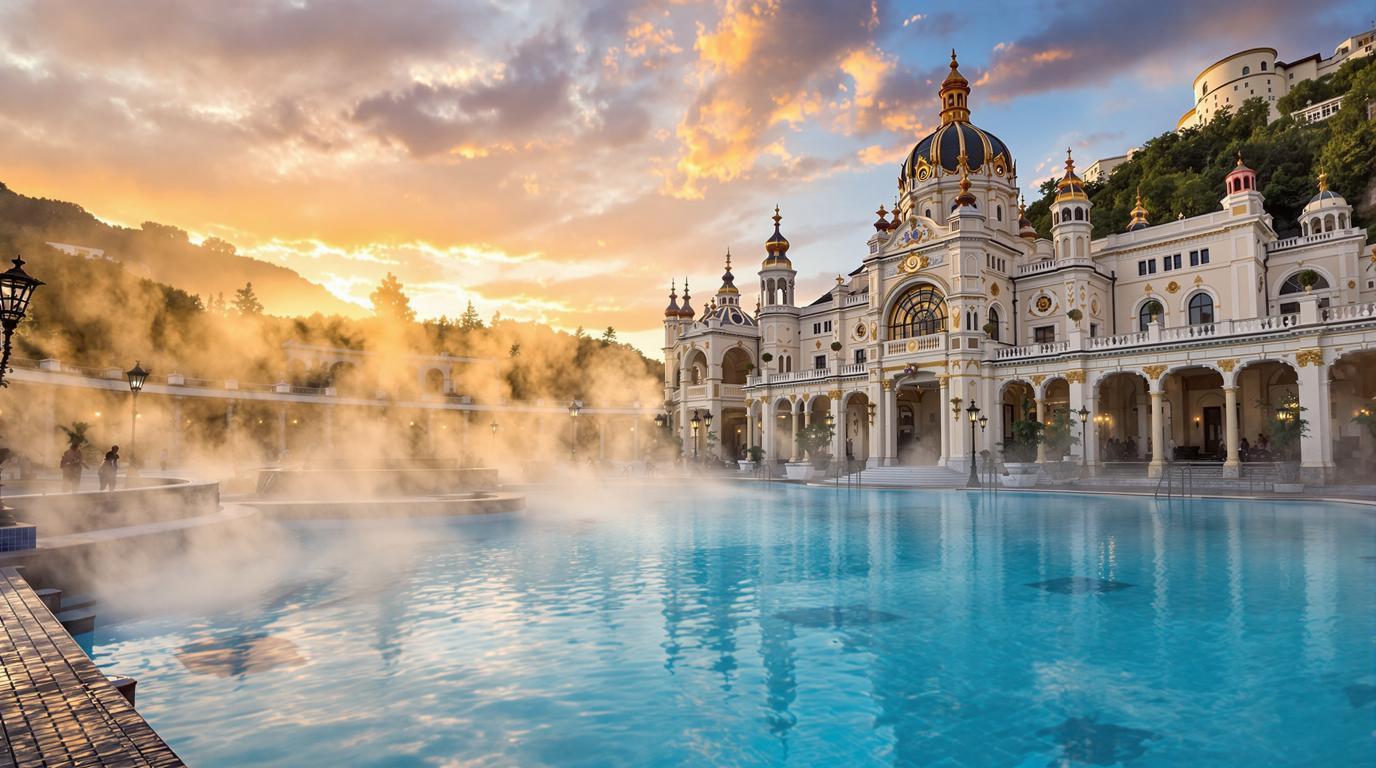The steam rising from ancient thermal pools tells a story Vienna’s tourists never hear. During my photography assignment along the Danube, I discovered that Budapest’s 1.75 million residents guard something extraordinary. While Vienna showcases imperial grandeur, this Hungarian capital harbors over 100 natural thermal springs that have bubbled beneath the city for millennia. The locals whisper about their “Pearl of the Danube” with protective pride, knowing that most visitors rush past toward more famous Austrian destinations.
Budapest isn’t just another Central European capital competing with Vienna’s baroque splendor. It’s a living thermal sanctuary where Roman legions once soaked in healing waters, where Ottoman sultans built elaborate bathhouses, and where modern Hungarians continue a 2,000-year wellness tradition. Standing 525 kilometers east of Vienna, this divided city straddles the Danube with Buda’s hills rising 230 meters above Pest’s plains, creating a geographic drama that Vienna’s flat imperial district simply cannot match.
What struck me most wasn’t the neo-baroque architecture or the UNESCO World Heritage sites. It was watching locals disappear into steaming pools at dawn, emerging hours later with a serenity that no Vienna coffeehouse can provide. This is where authentic Central European spa culture survived, flourished, and remains refreshingly affordable compared to Austria’s expensive wellness retreats.
The thermal empire that predates Vienna’s palaces
Where Roman legions discovered liquid gold
Long before Vienna became the Habsburg capital, Roman soldiers stationed at Aquincum discovered Budapest’s therapeutic springs. Today, archaeological evidence reveals 1,100 years of continuous thermal bathing culture that Vienna never possessed. The largest medicinal bath in Europe, Széchenyi, channels water from springs reaching 77°C deep underground, cooled to perfect 18-38°C pools that locals consider their birthright. Unlike Vienna’s limited spa options, Budapest offers 13 major thermal complexes, each with distinct mineral compositions and healing properties.
The Ottoman legacy Vienna erased
While Vienna expelled Ottoman influence, Budapest embraced it, creating architectural fusion impossible elsewhere. Rudás Baths, built in 1566 under Turkish rule, features an octagonal pool beneath a 500-year-old dome where steam swirls like incense. Local thermal bath historian József Pálmai told me, “Vienna destroyed its Turkish baths, but we preserved ours because they worked.” This cultural layering creates an authentic spa experience that Vienna’s sanitized wellness centers cannot replicate.
The affordable luxury that shames Vienna’s prices
Where €44 unlocks imperial wellness
Here’s what Vienna tourists miss: world-class thermal experiences at medieval prices. Széchenyi’s full-day entry costs €44, while Vienna’s comparable spa treatments start at €100. Gellért’s therapeutic massages begin at €28 for 45 minutes, compared to Vienna’s €60 minimum. A Budapest local named Eszter, soaking in Széchenyi’s outdoor chess pool, laughed when I mentioned Vienna’s spa costs. “Why pay triple for artificial wellness when we have nature’s pharmacy beneath our feet?” This authenticity mirrors England’s Roman bath heritage, but Budapest’s remains vibrantly alive.
The summer secret locals guard jealously
July transforms Budapest’s thermal baths into urban oases. While Vienna swelters at 29°C, Budapest’s outdoor thermal pools provide perfect refuge. Széchenyi’s 18 pools create temperature gradients from refreshing cool to therapeutic hot, allowing natural air conditioning unavailable in Vienna’s limited spa facilities. Locals time their visits for early morning or evening golden hour, when thermal steam creates mystical atmospheres that no Vienna spa can manufacture.
The exclusive thermal culture Vienna abandoned
Where locals practice thermal democracy
Budapest’s thermal culture transcends class boundaries in ways Vienna’s exclusive wellness industry never allows. Professors debate philosophy alongside construction workers in Széchenyi’s chess pools. Grandmothers teach thermal exercises to tourists in Gellért’s medicinal baths. This democratic wellness culture, rooted in centuries of thermal tradition, creates authentic social experiences that Vienna’s expensive spas actively prevent through pricing barriers.
The healing waters Vienna never discovered
Each Budapest thermal complex targets specific ailments through unique mineral compositions. Széchenyi’s calcium-magnesium waters treat joint problems, while Gellért’s sulfur-rich springs address skin conditions. Vienna possesses no comparable natural therapeutic infrastructure, forcing residents to travel to Austria’s alpine spas for similar benefits. This authentic wellness approach echoes Munich’s traditional spa culture, but Budapest’s thermal democracy remains unmatched.
Travel Note: Visit Széchenyi at sunrise for the most authentic experience. Locals arrive at 6 AM, when thermal steam creates ethereal morning mists and outdoor pools feel like secret sanctuaries. The chess games begin around 8 AM, creating perfect cultural immersion opportunities.
Frequently Asked Questions
How do Budapest’s thermal baths compare to Vienna’s spa options?
Budapest offers 13 major thermal complexes using natural mineral springs, while Vienna has limited artificial spa facilities. Budapest’s thermal experiences cost 60% less than Vienna’s wellness treatments, with authentic cultural immersion that Vienna’s commercial spas cannot provide.
Which thermal baths offer the best value for tourists?
Széchenyi provides the largest variety with 18 pools and iconic outdoor chess games for €44. Gellért offers luxury hotel amenities and wave pools for similar pricing. Rudás delivers authentic Ottoman atmosphere in smaller, more intimate settings for budget-conscious visitors.
Are Budapest’s thermal baths crowded during summer?
July brings peak tourist season, but Budapest’s multiple thermal complexes distribute crowds effectively. Early morning visits (6-8 AM) and evening sessions (after 6 PM) provide more authentic experiences with predominantly local users.
What makes Budapest’s thermal culture unique in Central Europe?
Budapest combines Roman foundations, Ottoman architecture, and Habsburg grandeur in active thermal facilities. This cultural layering creates authentic spa experiences unavailable in Vienna, Prague, or other regional capitals that lack comparable natural thermal infrastructure.
Budapest’s thermal empire represents authentic Central European wellness culture that Vienna’s tourist industry commodified and ultimately lost. While Vienna offers imperial architecture and coffee culture, Budapest provides living thermal traditions where locals and travelers share healing waters that have flowed for millennia. These aren’t museum pieces or tourist attractions—they’re active cultural sanctuaries where authentic Hungarian spa culture thrives daily. In a world increasingly dominated by artificial wellness trends, Budapest’s thermal baths offer something Vienna simply cannot: genuine therapeutic tradition rooted in natural springs and sustained by local pride.
